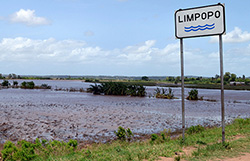Early flood warnings save lives in Mozambique

 JOHANNESBURG -- Late last month Argentina Guamba made a harrowing yet familiar journey. In the face of a rapidly rising Limpopo river, she gathered her family and made her way on foot from her home in Chókwè, in southern Mozambique, to a refuge camp set up in Chiaquelane, nearly 20 miles away.
JOHANNESBURG -- Late last month Argentina Guamba made a harrowing yet familiar journey. In the face of a rapidly rising Limpopo river, she gathered her family and made her way on foot from her home in Chókwè, in southern Mozambique, to a refuge camp set up in Chiaquelane, nearly 20 miles away.
It was the second time in 13 years that Guamba made the trip, seeking shelter from rising floodwaters by trekking to Chiaquelane. In 2000 she rode out a series of storms there, losing everything to floods that devastated the region and killed 700 people, displaced more than 650,000 and affected 4.5 million, a quarter of Mozambique's population.
Despite the dangers, Guamba--along with tens of thousands of her neighbors--moved back into the region after the last floods. "I have my fields there," she told the IRIN news service. "The soil is good for tomato, rice, cabbage, for everything."
This year's flooding has claimed far fewer lives -- 100 have been reported dead so far -- and local, national and international agencies seem more equipped to handle the devastation and humanitarian crises that have followed. Many are saying this is due to better coordination between government officials and aid agencies and improved early warning systems that have been distributed throughout Mozambique since 2000.
"Mozambique's long-term challenge is to learn to live with floods and drought," began a case study (pdf) conducted by the World Meteorological Organization during the soul searching that followed the 2000 floods -- one of the most devastating natural disasters in the country's history. The paper found that Mozambique's National Institute of Meteorology was woefully ill-equipped for the flooding that occurred. It called on the local and international organizations to invest heavily in preparedness for the flood-prone area.
Between 2009 and 2011 alone, cash-strapped Mozambique invested $275 million to try to reduce the risk of flooding. In that same period international donors added an additional $317 million.
In the years since the last major floods, members of National Institute for Disaster Management were trained in administering CPR and given radios to receive warnings and pass them on in their rural communities. Survival kits equipped with whistles, megaphones and life jackets were also given out to local officials, and residents were taught a color alert system.
The Mozambique Red Cross Society modeled much of the early warning system off of similar programs in the Philippines and Latin America.
Even with the country's heavy investments, the magnitude of this year's floods caught many off guard.
"It is difficult to help everybody at the same time ... but as soon as the floods began, the government started to work," Ana Cristina Joao Manuel, national director of prevention and mitigation in Mozambique's National Institute for Disaster Management, said to IRIN. "There will always be complaints in a situation like this. It is natural," she added.
By January 28, residents of Gaza had swarmed the camp at Chiaquelane, many forced to survive on one meal a day until international response ramped up to meet the need.

Government officials and international organizations are learning the lessons from these latest floods. Aside from building a series prohibitively expensive dams upriver, there is little Mozambicans can do but prepare for the next deluge.
Thirteen rivers flow across southern Africa and through Mozambique before emptying into the Indian Ocean. The Limpopo traverses much of southern Africa, separating South Africa from neighboring Botswana and Zimbabwe before it cuts across Mozambique's Gaza province towards the sea. Chókwè sits in the middle of Gaza and is at the mercy of all of the dams, dykes and water control systems that lie upriver. It's estimated that half of the water that flows through Mozambique comes from outside the country, and often local officials must rely on their South African, Swazi and Zimbabwean counterparts to keep them in mind when controlling their catchment areas.
"We have had situations where the South Africans did not warn us in time they were going to do discharges, with an interval of only two days," Suzana Laforte, head of Mozambique's water board, told the local paper Savanna.
Photos: flickr EU Humanitarian Aid and Civil Protection and mashleymorgan
This post was originally published on Smartplanet.com